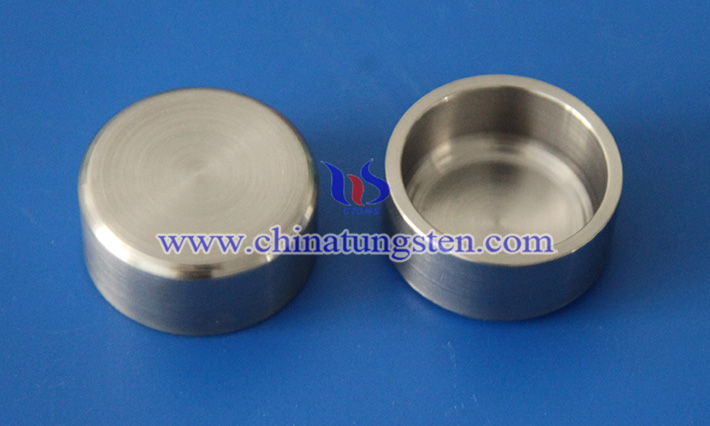How to Optimize the Performance of Tungsten Crucible?
- Details
- Category: Tungsten Information
- Published on Monday, 09 June 2025 15:14
The development of high-end manufacturing industry has put forward higher requirements for the temperature resistance, thermal shock resistance, structural stability and service life of tungsten crucibles.
In order to better meet various extreme working conditions, the performance optimization of crucibles has become an important topic in manufacturing and application. The following will discuss the performance optimization path of crucibles from the aspects of raw material selection, densification process, microstructure control, surface modification and composite materials.
1. Use high-purity tungsten powder raw materials
The first prerequisite for optimizing crucible performance is the use of high-purity tungsten powder. Impurities such as oxygen, carbon, iron, silicon, etc., can form a low melting point phase or brittle phase at high temperatures, weakening the overall mechanical properties and corrosion resistance of the crucible. In modern manufacturing processes, tungsten powder with a purity of higher than 99.95% is often prepared by high-temperature hydrogen reduction method, and the impurity content is strictly controlled in the subsequent process to ensure the long-term stability of the crucible under high-temperature vacuum or inert atmosphere.

2. Improve the density of the crucible
The thermal stability and anti-osmotic properties of a crucible are closely related to its density. After pressing and molding, the sintering process in a high-temperature hydrogen atmosphere or vacuum environment can significantly increase the density of the crucible. Hot isostatic pressing (HIP) technology not only further eliminates porosity, but also improves grain structure, overall mechanical strength and crack resistance. The increase in theoretical density reduces the sublimation loss and chemical reaction probability of the material during high-temperature use, thereby extending the service life of the crucible.
3. Optimize the grain structure
The grain size and distribution of the crucible directly affect its thermal expansion characteristics, thermal shock resistance and high temperature strength. The use of fine-grained tungsten powder and optimized sintering parameters can achieve a uniform and fine grain structure, enhancing the toughness and crack resistance of the material. In some applications, the addition of trace alloying elements (e.g., La, K, Re) can further inhibit grain coarsening, improve high-temperature strength and ductility, and make the crucible less prone to cracking under frequent alternating hot and cold conditions.
4, carry out surface modification treatment
Tungsten oxide (WO₃) is easily generated in a high-temperature oxidizing environment, which reduces the service life. Therefore, the surface of the tungsten crucible can be protected according to the conditions of use. For example, the use of physical vapor deposition (PVD) or chemical vapor deposition (CVD) methods to deposit a layer of corrosion-resistant and high-temperature resistant coatings such as molybdenum, tantalum or tungsten nitride on the inner surface of the crucible can effectively reduce the reactivity with the melt or atmosphere, and improve the overall corrosion resistance and oxidation resistance.
5. Development of tungsten matrix composites
In order to take into account the strength and toughness under different working conditions, the crucible performance can be optimized through material composite design. For example, carbides, oxide particles, or fiber-reinforced materials (e.g., ZrO₂, La₂O₃) are introduced into the tungsten matrix to form disperse strengthened or phase-bounded strengthened structures. This composite material not only improves the thermal shock stability and fracture toughness, but also improves the thermal fatigue resistance of the crucible, especially suitable for high-temperature and drastic environments such as single crystal drawing and electron beam melting.

6. Optimize the crucible structure design
The shape, wall thickness and dimensional structure of the crucible also have a significant impact on its performance. Finite element analysis and other simulation techniques can be used to optimize the design of the crucible wall thickness transition zone, bottom structure and stiffener, which can effectively reduce the thermal stress concentration and improve the crack resistance. At the same time, adjusting the roughness and thermal conductivity distribution of the crucible inner wall according to different use environments (e.g., electron beam melting, zone melting, or crystal pulling) can help improve melt flow stability and crystallization control.
7. Strengthen the management of the use process
Optimizing tungsten crucible performance depends not only on the manufacturing process, but also on the conditions of use and maintenance. In practice, the crucible should be avoided from being exposed to oxygenated atmosphere, and the rate of heating and cooling should be controlled to reduce thermal shock. In addition, inert gas purging and vacuum baking measures can be used before and after use to remove surface contaminants and avoid chemical reactions and crack formation caused by impurity adsorption.
- Chinatungsten Online: www.chinatungsten.com
- CTIA GROUP LTD: en.ctia.group
- Tungsten News & Price: www.ctia.com.cn
- Molybdenum News & Price: news.molybdenum.com.cn
- Tel.: 86 592 5129696; Email: sales@chinatungsten.com